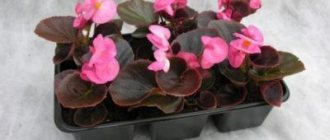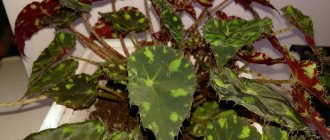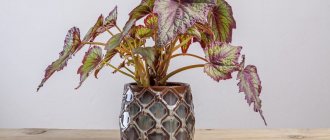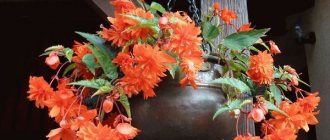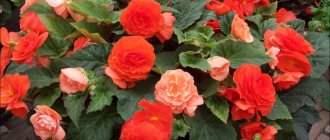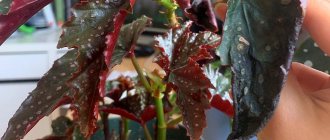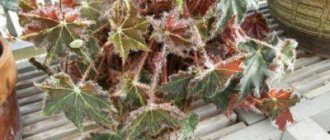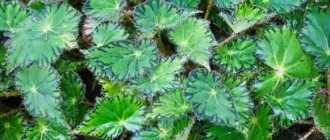Terry begonia is an amazing flower that can delight both indoor plant lovers and gardeners.
In the article we will talk about the features of terry begonia, its types, and most importantly, how to properly care for it at home.
This beautifully flowering shrub from the Begoniaceae genus has numerous carved leaves and large flowers reminiscent of small roses. The petals have a terry border at the tips, which explains the name of this flower.
Botanical description
The plant began to be grown indoors in the 17th century. The natural habitat is quite extensive - it grows in the vast expanses of Asia, Africa and America.
Currently, a lot of different varieties have been bred, differing in the shape and size of flowers, their color and cultivation characteristics. A popular variety available for sale is considered “Terry Mix Begonia ,” which is available in several colors.
As the begonia grows, it develops two unisexual flowers – male and female. Male buds have double petals, while female buds perform the function of reproduction - a seed pod is formed on them.
Most varieties feel great in open ground, where plants can be planted in late spring. With its flowering, terry begonia can delight the entire warm period, and sometimes even in winter.
How to grow begonia - a universal flower for home and garden
This amazing and beautiful tuberous flower can unusually decorate both your apartment and your garden in the spring and summer!
Begonia is an ideal lush flowering plant for pot and vase cultivation. It will grow well in open ground - in a formal flower garden, on an alpine hill or in a mixborder.
Begonia is amazingly diverse and always incredibly good. In our country, it is mainly grown as a houseplant, although in the summer, just like, for example, dahlia or gladiolus, it will grow wonderfully in a ceremonial flower garden or in a high sunny flowerbed.
In this article we will tell you how to grow begonia at home and how to decorate your summer cottage with it.
BIOLOGICAL PORTRAIT OF BEGONIA
Begonia is a tropical long-flowering plant native to South America. It belongs to the largest biological genus Begoniaceae, which includes more than a thousand diverse species.
Among them you can find annuals, herbaceous perennials, lush flowering shrubs and even vines. Ever-flowering begonia (Begonia semperflorens) is most suitable for indoor conditions, greenhouses and winter gardens .
The first two species are easier to grow from already formed tubers, while the second two grow quickly from seeds.
Begonia is grown indoors as a perennial crop. In summer, it can be displayed in pots and vases in flower beds, alpine hills, and ceremonial flower beds.
Some gardeners plant plants directly in the ground and care for them like dahlias until the end of September, and then dig them up, carry out appropriate preparation and store them for the winter.
For details on how to do this, read the articles we have already published:
But most often, begonias are transplanted into large pots in early September, completely replacing the soil in them, and continue to be grown as indoor flowers.
Begonias can uniquely decorate any room. They are distinguished by an extraordinary variety of shapes and bright colors.
Large-leaved begonia, for example, is very similar in flower shape to a ground cover rose. And fringed begonia is similar to large-flowered double carnation.
As a rule, the flowering of begonias begins in late April - early May, and ends in early October. Then the plants begin a period of rest.
Ever-blooming begonia is a very unpretentious plant in the form of a free-growing bush from 25 to 50 cm in height, which during the flowering period is entirely covered with surprisingly delicate and beautiful flowers.
It does not require careful care and reproduces easily.
But evergreen begonia can add amazing charm, delicate beauty and magical comfort to your home or blooming garden, which not many even the brightest and most beautiful flowers can create.
A LITTLE HISTORY OF THE APPEARANCE OF BEGONIA CULTIVATES
The largest thickets of wild begonia are located in Brazil. Here you can find lush bushes up to 1 m high, stunningly beautiful vines hanging down to the ground and covered with large bright flowers.
But most species are still evergreen spreading perennial bushes up to 50 cm high.
Begonia was brought to Europe by workers of the British Botanical Garden at the beginning of the 18th century. British breeders really liked begonia, and they began to cross it with other species of this plant.
As a result, unique cold-resistant varieties were obtained that bloom almost all year round.
From those ancient times until now, scientists have managed to develop more than 600 ever-flowering varieties and hybrids of begonias with unexpected, single- and multi-colored bright colors of large flowers of the most amazing and bizarre shapes.
Depending on the variety, the leaves of the plant also received different colors - from soft green, emerald, coral-red - to bright golden, orange and reddish-burgundy.
HOW TO GROW BEGONIA FROM SEEDS IN ROOM CONDITIONS
Ever-blooming begonia is a very fast growing plant. Therefore, it is easy to grow from seeds and subsequently cultivate indoors as a perennial crop.
Preparing for landing . The period from sowing the seeds to the beginning of flowering takes the plant only three months. Therefore, sow in pots (with a diameter of 15 - 20 cm, and then, as they grow, in larger containers) in February - early March, filling them with ready-made soil for indoor flowers.
Soils. Begonias need very fertile, loose and slightly acidic soil, so add 4 tbsp to the prepared flower soil. spoons of purchased peat and to increase fertility - 3 tbsp. spoons of vermicompost.
Sowing . Begonia seeds are very small, so plant several seeds in a permanent pot. Before filling it with soil, lay a drainage layer of sand mixed with perlite in equal quantities at the bottom in a layer of 5–6 cm.
Wet the soil well, let the water go down and place 3 - 5 seeds on the surface. There is no need to embed them in the soil. It’s easy enough to press it into the ground and cover it with a transparent film on top.
Maintain the room temperature within +22 ... +24 degrees.
Watering . Once every 3 days, very carefully lift the film and water your plantings with warm water through a strainer so as not to wash off the seeds from the surface of the ground.
Care . In two weeks the first shoots will appear. Then remove the film and place the pots on the south window. Since the illumination for begonias in February - March is not yet sufficient, use additional illumination with fluorescent lamps - 2 hours in the morning and 2 hours in the evening.
When each begonia has two true leaves, you can leave two plants in one pot. Then the bush will be more magnificent. Place the rest in other containers.
In May, your flowers will begin to bloom for the first time. During this period, indoor watering should be carried out daily.
Feeding . In May, feed the plants with urea (a teaspoon of urea per two-liter bottle of water). Water slowly through a strainer until all the soil is saturated with moisture.
After flowering begins, feed begonias twice a week with complete mineral potassium fertilizer.
Rest period . From the end of October to the end of January, all begonias are dormant. During this period, watering should be reduced to once a week, and the room temperature should be reduced to +15...+ 18 degrees.
As the root tuber grows, the begonia needs to be transplanted into larger containers, completely replacing the soil in them (usually this needs to be done once every 3 to 4 years).
HOW TO GROW BEGONIA FROM A TUBER
The process of growing begonia from a tuber is much simpler. If you want your beauties to bloom as early as May, plant them in pots with peat mixture in mid-February.
For later flowering (in July), plant the tubers after May 20 directly in the ground. Preparation for planting, planting, care and harvesting of begonia tubers is done in the same way as for dahlias.
Please read our above published articles carefully:
THE BEST VARIETIES OF BEGONIA FROM OUR COLLECTION
Now that you know how to grow begonia for your home and garden, we offer you our most fashionable and unusually beautiful varieties:
Begonia seeds:
You can order seeds of these varieties from us today on our website or from the “SEEDS 2021” catalogue.
Begonia tubers:
Large-flowered CAMELIA; A set of large-flowered varieties BENEFIT.
Sets of fringed varieties:
Order begonia tubers from the SPRING 2021 catalog or on our website.
Plant begonias at home and admire their lush blooms all year round!
Source
Titles and photos
Terry begonia is represented by numerous subspecies, each of which has its own distinctive characteristics. Below are photos and descriptions of terry begonia varieties suitable for propagation and care at home.
Yellow
It is a small bush with recumbent, highly branching shoots, distinguished by the yellow color of the inflorescences. The flowers of yellow begonia are quite large - up to 4 cm in diameter and consist of many petals. The leaves are medium (up to 20 cm in length). The height of this variety does not exceed 50 cm. Among the popular varieties of this variety are:
- Picoti;
- Full yellow;
- Ampelous Cascade yellow (Pendula).
Red
It has red lush flowers up to 10 cm in diameter and patterned bronze leaves. The height of the plant is approximately 20-30 cm. Red begonia blooms from May to October. At the same time, you can enjoy the beauty of its flowers for 2-4 weeks. The photo below shows a red terry begonia:
Pink
Differs from other varieties with pink inflorescences. Reaches half a meter in height and is often used for planting in open ground. Pink begonia feels great in a well-lit flowerbed and, with enough fertilizer, will bloom luxuriantly from May to October . Look at the photo below to see what the terry pink variety looks like:
Scarlet
This subspecies has rich burgundy-red flowers with lush fringe along the edges and large leaves of a bronze hue. This variety looks very advantageous in a composition with other flowers, contrasting brightly against the general background. The photo below shows the terry Scarlet variety:
White
White begonia looks very delicate and elegant. The height can reach 25-30 cm. White flowers with corrugated petals are very voluminous - 10-12 cm in diameter. They have a pleasant sweet aroma. Flowering duration is 2-3 weeks.
Subspecies
The appearance and process of growing the plant makes it possible to divide begonia into 5 main varieties:
- shrubby;
- ever-blooming;
- tuberous;
- stem;
- root.
Each type is individual. Among these five varieties, decorative-flowering and decorative-deciduous subspecies are also conventionally distinguished.
- Decorative deciduous begonias noticeable by long succulent leaves growing directly from the root. The foliage amazes with its beauty and diversity. They are colored from bright green, silver, red-yellow to dark brown.
The most popular representatives:- Royal begonias;
Metallica;
- Bauer;
- Cleopatra.
- Decorative flowering species combines plants with smooth and double inflorescences, at the same time bright, original colors. Despite the weather conditions, begonias of this subspecies are ready to bloom all summer long.
Famous varieties:- Ambassador.
Rosemary.
- Cocktail
- Gloire de Lorraine.
- Marina.
- Terry.
You will learn about how the ever-flowering begonia reproduces here, and in this article we talked about the rules of planting and subsequent care of this variety of plant.
Care
You can get a healthy, beautifully flowering plant only by following certain rules for caring for it. We'll talk about them further.
Location and lighting
Begonia is photophilous, and therefore it needs additional lighting in the cold season. In hot weather, the flower should be protected from direct sunlight , the contact of which on the leaves can cause burns and overheating.
For symmetrical growth of the bush, the pot with begonia must be periodically rotated 180 degrees.
Watering and humidity requirements
During the period of active growth - spring and summer, the plant needs abundant watering - twice a week. In winter, you need to reduce the number of waterings by about 1.5 times.
Excessive watering can lead to the death of the plant, so make sure that the top layer of soil dries out.
Because
The tap water is too hard ; for irrigation, use settled water at room temperature.
The terry beauty will delight you with its beauty if you provide it with the necessary air humidity. For these purposes, you can use a humidifier or spray the air around the plant, preventing droplets from getting on the leaves and flowers.
A container of water located next to the pot will also help achieve the desired result.
Temperature
Terry begonia prefers an average temperature of 18-23 degrees in summer and not lower than 15 degrees in winter. The flower pot should be ventilated periodically, while protecting it from drafts and sudden changes.
Top dressing
The plant needs to be fertilized during the warm period - spring and summer, because... It is at this time that it needs additional support. Fertilizing should be done no more than 1-2 times a month . This will be enough for the full growth and strengthening of the health of the flower.
In the summer, it is better to use potassium and phosphorus fertilizers, and after winter awakening, nitrogen fertilizers.
The solution for feeding begonias should be diluted more than indicated on the package, because the flower reacts sensitively to an excess of fertilizers.
Transfer
Transplantation depends on the growth rate of the flower - if there is not enough space, it should be placed in a pot of larger diameter. Typically, replanting is carried out every two years in early spring . Tuberous varieties must be replanted annually after wintering.
Soil composition and pot
To keep begonias, it is better to purchase a clay pot with drainage holes at the bottom, which will provide oxygen access to the roots of the flower.
The plant prefers loose, slightly acidic soil with sufficient fertilizer.
You can prepare the soil yourself by including in its composition:
- 2 parts leaf soil;
- 1 part humus;
- 1 part river sand;
- 1 part peat.
If you can’t make the soil mixture yourself, you can buy a ready-made one in the store.
The plant needs a drainage layer, which must be placed at the bottom of a pot made of expanded clay or broken brick.
Frequency of pruning
It is necessary to prune when the main stem reaches 10 cm in length . It is pinched, thereby ensuring the growth of side shoots. The latter are also subject to pruning upon reaching 10-12 cm. Subsequent pruning is carried out only as needed and to give the bush the desired shape.
Priming
Ever-blooming begonia, which is easy to care for, prefers loose, fertile soil with a slightly acidic reaction. The area for planting crops should be prepared in advance.
To do this, you will need to dig up the soil and add it to each square. m 20 liters of compost, rotted manure or lowland peat. This can be done a day before planting. If the soil on the site is heavy, then it is additionally worth adding sand to it, using 2-3 kg per 1 square meter. m.
Instead of organic fertilizers, mineral fertilizers can be used to improve the soil.
Then for every 1 sq. we will need to make the following fertilizing:
- potassium salt – 100 g;
- superphosphate – 250 g;
- Ammonium nitrate – 150 g.
Slightly acidic soil is recommended for begonias.
Begonia does not tolerate stagnation of moisture at the roots. It is not suitable for lowlands, wetlands and places with close groundwater. It is better to plant a flowerbed for cultivation on a small hill. You will also need to arrange drainage under the flower bed in advance by laying out a layer of shell rock, broken brick, small crushed stone or gravel.
Reproduction
You can propagate a flower in three possible ways:
- Using cuttings;
- By dividing the tuber;
- Seeds.
Let's talk about all the methods in more detail.
Propagation by cuttings
Propagation using cuttings is a fairly simple method that is suitable for all types of this plant. It is better to prune cuttings in early spring . Cuttings up to 10 cm long are suitable for propagation. The lower leaves must be removed and the cuttings placed in a container of water or soil.
When placing cuttings in water, it is better to put the container in a dark place to avoid water blooming or choose a dark container.
To speed up the appearance of roots, you can use Kornevin or another growth stimulator. Typically, roots appear within a week, after which the cuttings can be planted in the soil.
Rooting in the ground takes a little longer - after 4-5 weeks. To do this, ensure a favorable soil temperature of 20-22 degrees.
Growing from seeds
The seed method is the most difficult in comparison with the others, because
the seeds are quite small and sensitive to external factors. Seeds are planted in January. The seeds are simply sown on the surface of the soil and lightly pressed against it. The container is covered with film to create a greenhouse effect.
To get good results you will need to create the following conditions:
- Provide additional lighting to future plants (+4-5 hours of daylight), which promotes subsequent flowering already in the year of sowing.
- Maintain a temperature of 22-25 degrees.
- Regularly ventilate the container with crops.
After 2-3 weeks, the first shoots can be observed, after which the film can be gradually removed using special phytolamps.
After the formation of 3-4 leaves, they can be planted in separate pots.
Tubers
This method only applies to tuberous begonias. Large healthy tubers with 4 to 7 buds are selected for propagation.
The procedure is quite simple:
- Using a knife, the tuber is divided into parts so that each of them has buds.
- Allow the cuts to dry for several hours, and then lay the tubers with their undersides on moist soil or gauze soaked in water.
- Place the tubers in a warm, well-lit place and wait for the roots to appear.
- Place the tubers in the prepared substrate and sprinkle a little earth around them, while the upper part of the tuber should remain on the surface (2-3 cm below the edge of the pot).
- After the first shoots appear, the tuber is completely covered with earth.
- Continue care as usual.
Feeding
Ever-flowering begonia (planting and caring for the crop is not burdensome) requires regular feeding, which should be done every 10-15 days. For this purpose, organic and mineral fertilizers can be used. But it is better to apply them in liquid form.
It is advisable to carry out the procedure itself early in the morning or at sunset. Before applying fertilizer, it is important to water the flower bed thoroughly. Otherwise, fertilizing will burn out the roots of the flowers.
At the beginning of summer, it is advisable to use fertilizers rich in nitrogen. Ammonium sulfate, urea, ammonium nitrate are suitable. When the buds begin to form, you should switch to phosphorus-potassium fertilizers. Suitable potassium sulfate or monophosphate, nitroammophoska.
It is even better to use fertilizers such as Kemira Lux and Fertika Flower. For every 1 sq. m of flower garden, it is enough to add 40 g of preparations.
From organic matter, begonia reacts well to a solution of mullein and bird droppings. But such fertilizing should be applied before flowering begins. They contain a lot of nitrogen, which stimulates the development of green mass. After the buds form, you can switch to an infusion of wood ash.
Diseases and pests
Common diseases characteristic of the terry variety are:
- Gray rot, which appears from an excess of moisture in the room and lack of heat. In this case, the plant becomes covered with mold, which can be dealt with by spraying with special preparations. The affected areas of the flower should be carefully removed. It is also important to regularly ventilate the room if the begonia is kept indoors.
- Powdery mildew. The cause of this disease is frequent temperature changes, the presence of drafts and excess moisture. Outdoor plants are at risk. The disease is treated by treating with fungicides.
In addition to diseases associated with improper living conditions, pests also pose a danger . Among them are often found:
- A spider mite that entangles a plant and feeds on its juices. To get rid of a tick you will need a soap solution.
- Aphid. It also often attacks terry begonia, and getting rid of it is quite difficult - you will need to treat the flower with insecticides every day until the pests completely disappear.
Growing tips from the experts
To prolong the flowering of begonias and make it more lush, you will need to follow these recommendations:
- After watering, the bed should be loosened. This will prevent soil compaction, which will prevent the roots from getting enough oxygen.
- During loosening, weeds must be removed, because they are the main carriers of diseases and pests.
- It is advisable to sprinkle the surface of the bed with a layer of sawdust, peat or straw. Mulch will retain moisture at the roots, prevent weeds from appearing and prevent the soil from compacting. And organic matter will additionally nourish the flowers with useful elements. But the mulch layer will need to be updated regularly, as it is washed away by watering.
An attractive ever-blooming begonia will be a bright addition to any landscape. Moreover, areas in the shade of trees and shrubs, where not all ornamental plants take root, are suitable for planting them. At the same time, the culture is not demanding and does not require special attention in care.
Photo gallery
favorite_flower_kz
rastenia_ot_kateriny
rastenia_ot_kateriny
rastenia_ot_kateriny
Types of terry begonias
According to the nature of the underground part, terry begonias are tuberous and bush-like. The above-ground part of the plants also differs; some begonias grow vertically in the form of a bush, while others are hanging.
The largest and most beautiful flowers come from tuberous begonias, their size varies from 1.5 cm to 15-20 cm. The color of the flowers of such terry begonias can be red, white, yellow. Flowers with petal edges of different colors are possible. Sometimes begonia flowers have a scent.
Ampelous begonias are attractive because they, like other ampelous plants, have the ability to hang down and are able to entwine a support or trellis. They bloom very profusely, although the flower size is not as large as that of bush plants. There are large-flowered species with a flower size of 10-15 cm and small-flowered ones - up to 5 cm. They mainly bloom in the spring, but some varieties also bloom in the summer.
Most hanging begonias have white or pink flowers. It is most convenient to grow hanging plant species in hanging pots and baskets.
Possible difficulties
The unpretentiousness of the royal begonia sometimes makes the gardener almost forget about the plant. But, despite the absence of complex care procedures, the plant still needs to be monitored. This will allow you to notice the symptoms of diseases or the appearance of pests in time, and even better, prevent their occurrence in advance.
Diseases
Irregular or excessively abundant watering and a lack of nutrients in the soil can lead to the appearance of diseases such as gray rot or powdery mildew. A fungicidal agent will help against such fungal diseases. Sometimes begonia is also affected by bacterial diseases, which are treated with the same drugs.
Pests
Bushes can become a target for common pests of home and garden crops - whiteflies, thrips, scale insects, etc. The pest must be recognized as quickly as possible. In the early stages of the lesion, you can get rid of them with folk remedies, for example, with a soap solution. In advanced cases, insecticides are used. Increasing humidity will help prevent the appearance of pests - most insects prefer dry air.
Why doesn't indoor begonia bloom at home?
Reasons why begonia does not bloom
Most likely, it does not have enough light, the humidity is low, the temperature is not suitable, or you left it in a draft and overdid it with fertilizers.
Try to follow the care recommendations, change the location of the flower and the conditions of its maintenance: move it to another window sill or to a room where the temperature is suitable and there are no drafts.
How to make begonia bloom?
To ensure long and abundant flowering, they use the “short daylight” technique: for two weeks, the daylight hours are artificially reduced to 9 hours, covering the begonia with black film. Thus, the process of laying buds is activated. To prevent the plant from accelerating its growth in height at this time, it can be pinched 2-3 times. Then daylight hours double again. During the winter months, lighting is also necessary.
Compliance with the above rules of care will allow you to enjoy the luxurious beauty of flowering and enchanting aroma for as long as possible.
Take care of the begonia and take care of it, then the flower will bloom buds and smell, pleasing your eyes and smell!

